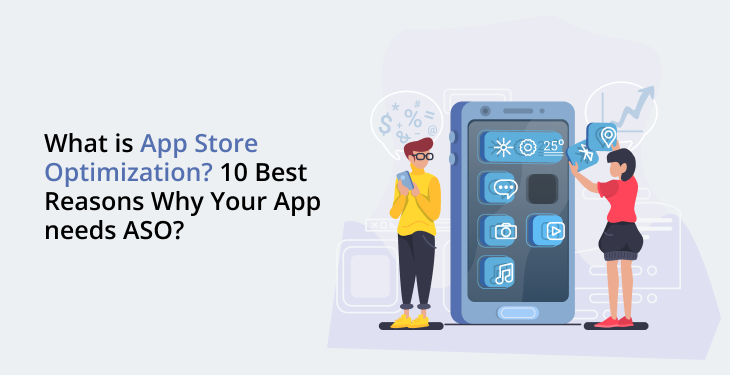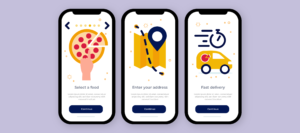Did you know that more than 6.5 million people own mobile devices? They frequently download mobile apps for daily chores like placing a pizza order, traveling, generating press, or even scheduling a romantic rendezvous.
Following the general trend, new developers continually search for a position in the market among the 3.55 million apps in Google Play and the 1.64 million apps in the Apple App Store. ASO, or app store optimization, is a technique for increasing app visibility among your target consumers. So let’s examine how this works.
To answer the following queries, we rely on our practical knowledge and reasons why your app needs ASO in this blog.
- What is the purpose of app store optimization?
- How does ASO help in increasing downloads?
- What are the primary and supporting elements of ASO?
- How do you optimize an app store?
- What is App Store Optimization?
What is App Store Optimization?
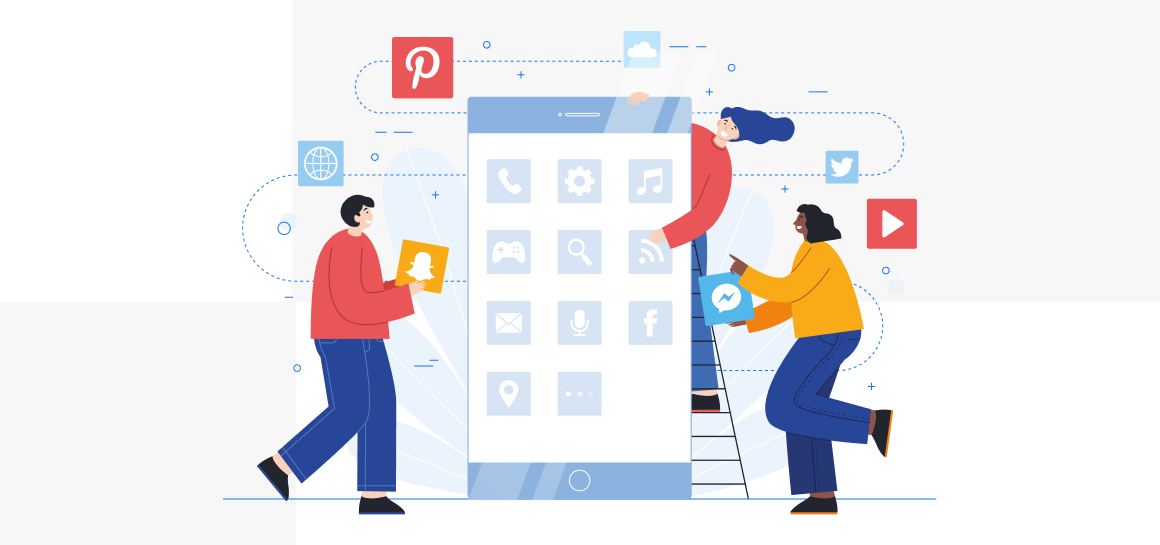
Similar to search engine optimization (SEO) for websites, app store optimization (ASO) promotes mobile applications on app stores. The top-ranked web pages are listed by the Google search engine when you enter the keyword or phrase in the search field. Similarly, app stores identify the most pertinent apps based on keywords, reviews, downloads, upgrades, and other ranking criteria. Both ASO and SEO are used to increase traffic to your resource and move it to the top of the search results.
In actuality, ASO encompasses a wide range of activities. These include A/B tests, backlinks, visual design, and the app’s title, description, and URL optimization. Together, they develop a plan for app store optimization.
Like SEO, app store optimization is a constant process of enhancing organic traffic and user base. ASO suggests monitoring and measuring KPIs like Click-Through Rate (CTR) to advance from one stage of your app’s visibility evolution to the next.
Reasons Why Your App needs ASO?
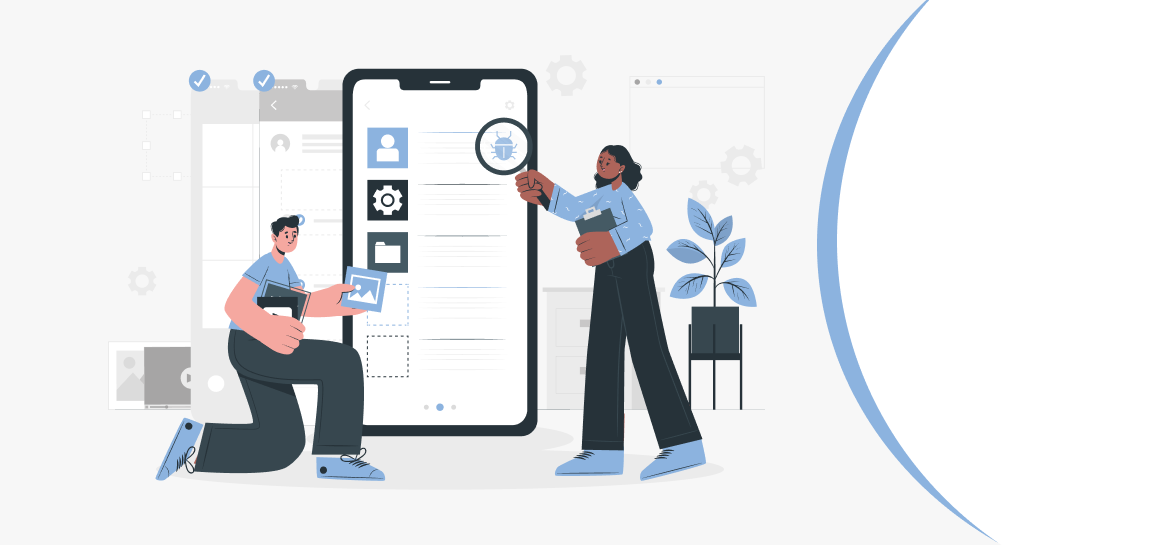
New, high-quality services are becoming more and more in demand. According to Statista, the volume of the app market will grow by 9.27% by 2026. But if it appears on the 999th line of search results, only some of the best programs will receive many downloads.
App store optimization helps increase developer visibility, user appeal, and the conversion of views to downloads. These are some of the reasons that your app needs ASO:
- A rise in organic traffic
- Relevant users who eventually develop into devoted clients
- Reduced user acquisition costs as a result of better search indexation
- Higher conversion rates
- Greater downloads
- Revenue increase
The Basics Of ASO
Now that you know the significance of app store optimization, how does it operate?
Fortunately, there are fewer factors in App Search than in Google Search. Simple app store optimization considers the primary and auxiliary variables affecting search algorithms.
The following aspects are the reasons why your app needs ASO.
1. Ranking:
The Google Play Store and the Apple App Store’s sophisticated algorithms keep track of various factors, including rankings. The formula is not linear, but better search returns are associated with higher ranks.
The app category, developer names, and titles all factor into the App Search algorithms. Additionally, the algorithms used by Google Play and the App Store depend on the following:
- Review ratings
- Review quantity
- Amount of downloads
- Rates of click-through
- App excellence (measured by usage and discard rates, and crashes)
- Updating routine
- The magnitude of a brand and more.
2. Backlinks:
The most common strategy error is underestimating the importance of the website and failing to incorporate ASO and SEO tools. Instead, we advise you to think of a website as a locomotive that drives traffic to your app store by pulling users through the search funnel. So keep in mind to provide backlinks between the app and your website.
Linking your app store to social media, LinkedIn and Upwork profiles, Quora resources, Dribble, Clunch, and Behance platforms is always a good idea.
3. Keywords optimization:
The most relevant app for the user’s search query is found by app store engines using keyword analysis. Therefore, it’s essential to include the best keywords in the app’s title, short and lengthy descriptions, and URLs, all of which are places the search algorithm initially browses.
The app store keyword research is the initial step in the keyword selection process. You can then determine which word is more popular with your target demographic. You can manually research your rivals or use third-party resources like AppTweak or Apple Search Ads. Metrics like keyword volume, difficulty, number of competitors, top competitors, long-tail variations, etc., can be provided by ASO tools.
The most important elements to consider are keyword volume and keyword difficulty. The volume of a given keyword indicates how well-liked it is by users. The keyword difficulty also indicates how challenging it will be to rank your app among the top 10 results of an app store search.
4. Visuals:
Your mobile app development is crucial because the user’s first visual impression of an app comes from the app icons, images, and sample videos.
The app icon should be neat and visually appealing. We advise putting as much effort into it as though it is going to be your most important visual signature.
Even though the initial screen of the app store also features the first three app screenshots, it is the first one that is highlighted. Video elements, in contrast to symbols and pictures, are optional. However, they also draw attention and boost productivity.
5. Keyword Metadata:
App metadata includes all written content, such as titles, subtitles, descriptions, and images and videos, including icons and screenshots. A list of keywords best describes your ad is known as keyword metadata.
You can input 100 keywords in the Apple App Store, separated by commas. For instance, real estate, homes, and property. Additionally, selecting natural keywords that correspond to users’ search terms is the primary goal of keyword optimization.
6. App Title:
Make a catchy name for your app. It can be necessary to look into the titles of your rivals’ products and to measure, prioritize, target, and conduct A/B tests. To entice the algorithm, use the keyword with the greatest influence. To avoid slowing down indexation and confusing consumers, we advise keeping the app title the same.
7. App Subtitle:
The three most important app metadata components are the catchy title, refined keyword set, and informative description. On the product page, the subtitle appears immediately after the title. The character limit for this sample is 30; therefore, it must be brief.
8. App Description:
We consider consumers who read the product page and those who utilize search engines when writing the descriptions for your apps. The goal is to use as many important keywords as possible while producing accessible, understandable writing.
Users will see the program snippets’ first 250 characters and must click “read more” to view the description. Most people don’t behave like that! Therefore, be sure that your opening three lines are compelling.
9. App Downloads:
The quantity of app downloads immediately comes to mind when you wonder how app store optimization functions. Downloads provide the most convincing evidence of the app’s popularity and are a key ranking factor for search engines. It also matters how many downloads were over the most recent time frame. If the app stops developing, new competitors with faster performance can surpass it.
10. App Reviews and Ratings:
Ratings for apps range from 1 to 5 stars. This is how the reputation of your app is quantified. Reviews are also text areas that users use to provide them with quality comments. Users’ primary trust indicators for apps are ratings and reviews, which are also considered by the algorithms used by Google Play and the App Store.
Ratings for apps have a significant impact. Users can see this social proof indicator every time they use the app in search results, top charts, and highlighted pages. Most people will only read the title if the rating is at least four stars.
Reviews of apps frequently help in decision-making. Whether reviews are positive or negative, people still value them. They don’t get deleted, which is another distinction. You will always have access to these user comments. For this reason, we advise you to set up a system for obtaining frequent, interesting reviews and responding to them, especially the unfavorable ones.
The Difference between ASO and SEO
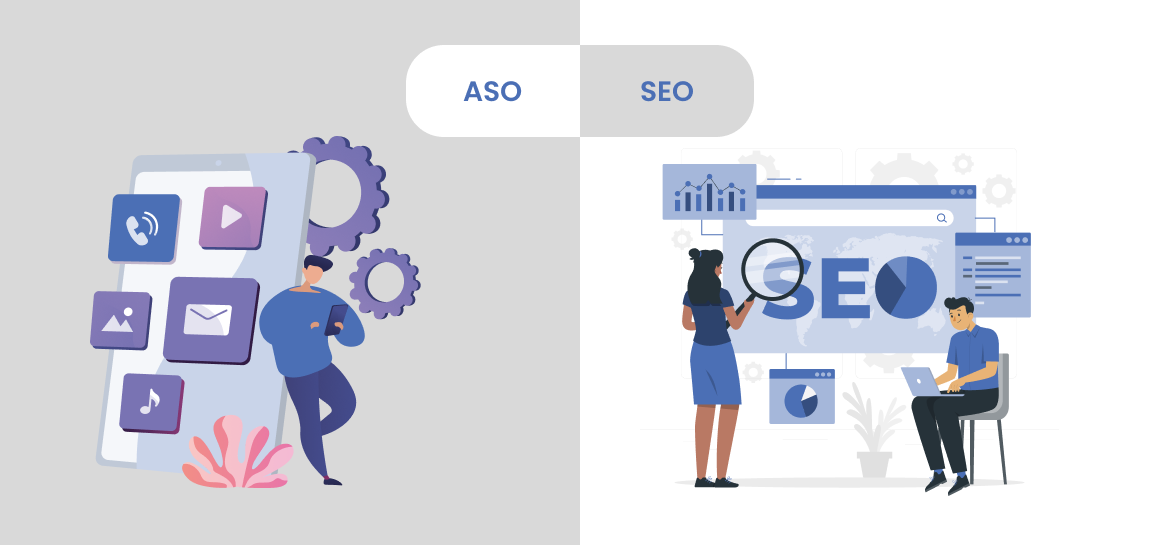
You may use two main strategies to market your app: SEO (Search Engine Optimization) and ASO (App Store Optimization). Both are successful in their ways, but there are some important distinctions between them. Here are some insights on how SEO and ASO differ from one another:
| Basis | SEO | ASO |
| Definition | SEO, or search engine optimization, involves raising the positions of your web pages in natural search engine result pages to increase the quality of visitors to your website. | ASO, or app store optimization, enhances an app’s exposure in the app stores to boost natural app downloads. When apps consistently rank highly for a wide range of search phrases, stay towards the top of the rankings, or are highlighted by the store, they become more prominent. |
| Objective | Increasing website visitors | Increasing app downloads and visibility. |
| Search Engine | Google, Bing, and Yahoo are examples of organic search engines. | App store search |
| Ecosystem | World Wide Web | App stores like the Google Play Store and the Apple App Store |
| Search intent | General inquiries, details and responses to goods and services, and website searches. | Finding need-based applications |
| Ranking elements (on page) | i. Title and header tags with keywords
ii. Content quality, structure, and relevancy. iii. Meta tags and optimized URLs |
i.App’s name, subtitle, and description
ii. Keyword density and field iii. Name of the author |
| Ranking elements (off page) | i. Time spent, speed, and backlinks
ii. Bounce rate and click-through rate iii. Domain authority |
i. Download volume and speed
ii. The conversion rate iii. Engagement and Retention |
Benefits of ASO for Business Growth

1. Increase brand recognition
One of the major advantages of ASO is that it can enhance your app’s visibility in the app stores, even if users weren’t initially searching for you.
When you realize that the most popular way for customers to find new apps is through searches, ASO becomes even more crucial.
2. Lowers the cost of acquiring users:
Using app store optimization as a long-term marketing strategy is fantastic.
Once it’s set up, you can increase organic downloads with no further expense or very little. This can significantly reduce your acquisition costs.
3. Ensures long-term app visibility:
ASO is a key component of ongoing, sustained app presence.
As you’ve seen in the preceding section, ASO can produce effects for a lot longer after the hard effort has been put into it. On the other hand, paid advertisements need ongoing funding to draw people.
4. Enhanced user targeting:
Even if you have the best app in the world, your retention rate is likely to decrease drastically if the incorrect users are using it.
Another reason ASO is crucial is that it helps you reach the right users to download and use your app.
5. Increases sales:
We have been discussing how ASO decreases expenses and raises brand recognition.
However, they all truly point to one main advantage: it can increase your revenues.
ASO can increase your app’s visibility, encouraging more users to download it. Additionally, the more people you have, the more money you can make.
6. Assists in expanding your global audience
App store optimization is essential if you wish to use app localization to access international markets.
Localization is customizing a page in your app to represent the language and culture of a different market.
To use a fast food example, consider how McDonald’s alters its menu selections based on the nation.
Conclusion
App Store Optimization is a potent boost to increase an app’s visibility and recognition in the Apple App Store, Google Play, and other app stores. However, putting ASO best practices into effect takes a long-term plan, expertise, and research tools. Examples include optimizing the app’s title and description for keywords and utilizing images, reviews, backlinks, and A/B tests.
Investing in ASO will unavoidably lead to higher conversion and more downloads. We can help if you require professional guidance on ASO strategy, product branding, or mobile development.

